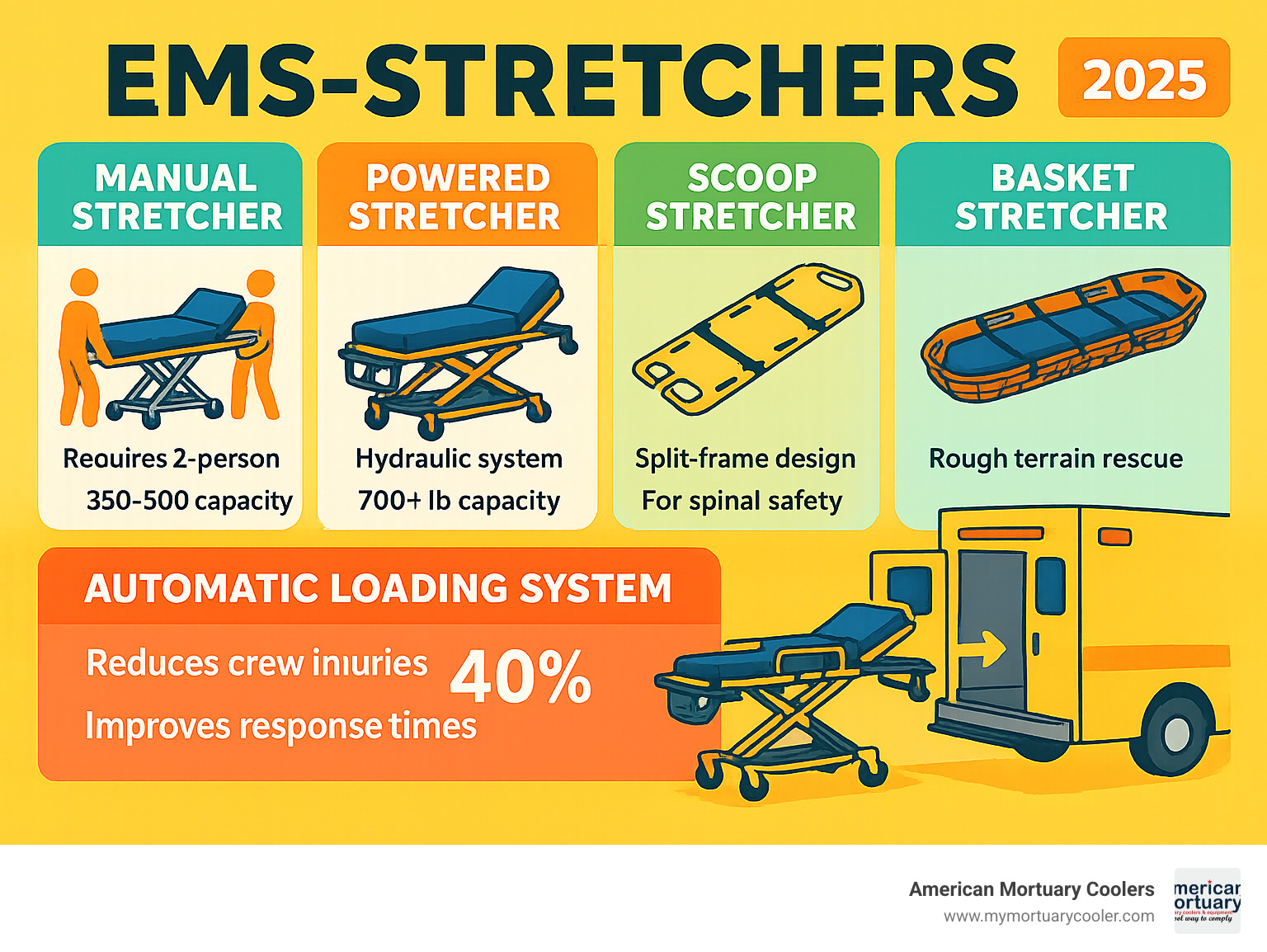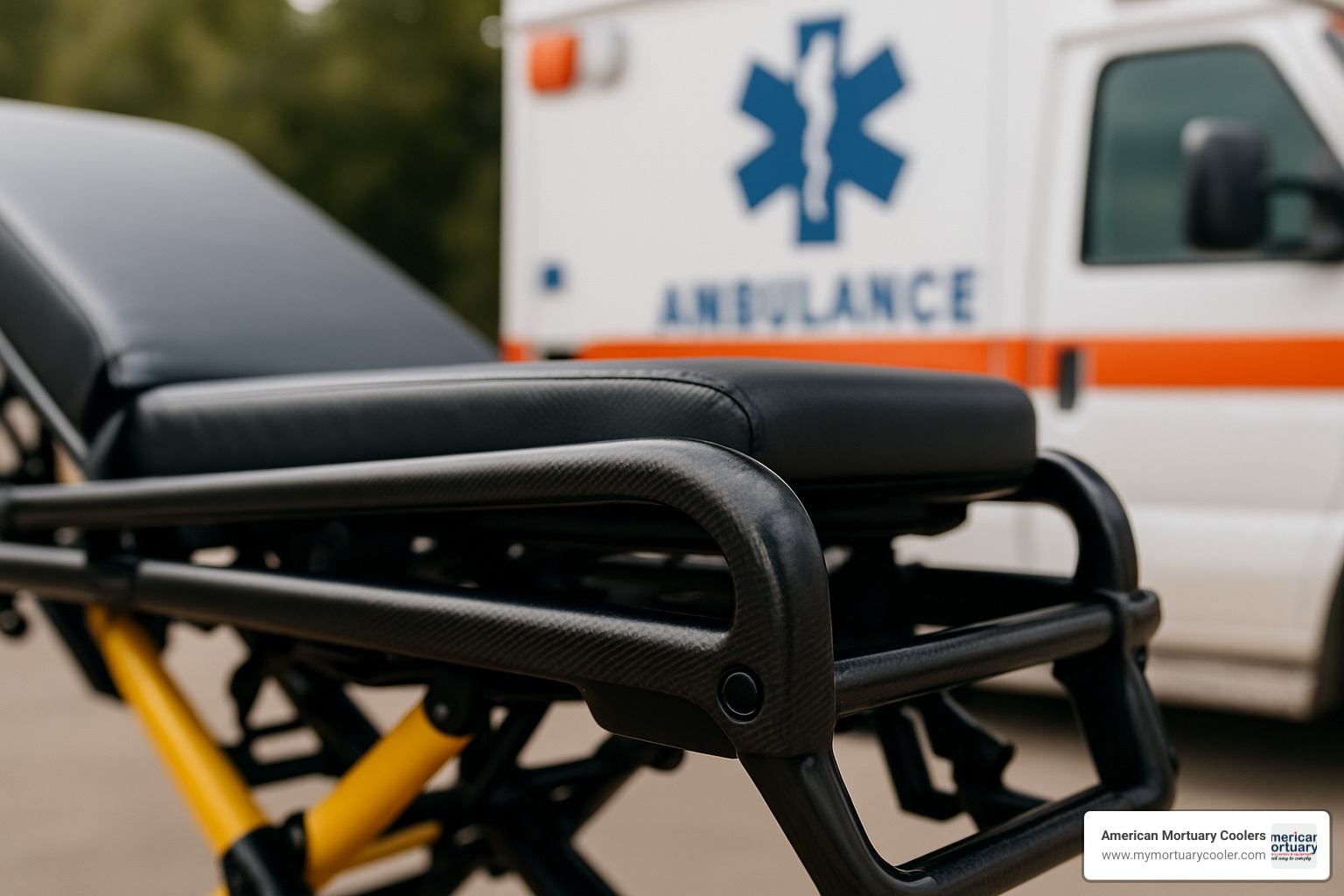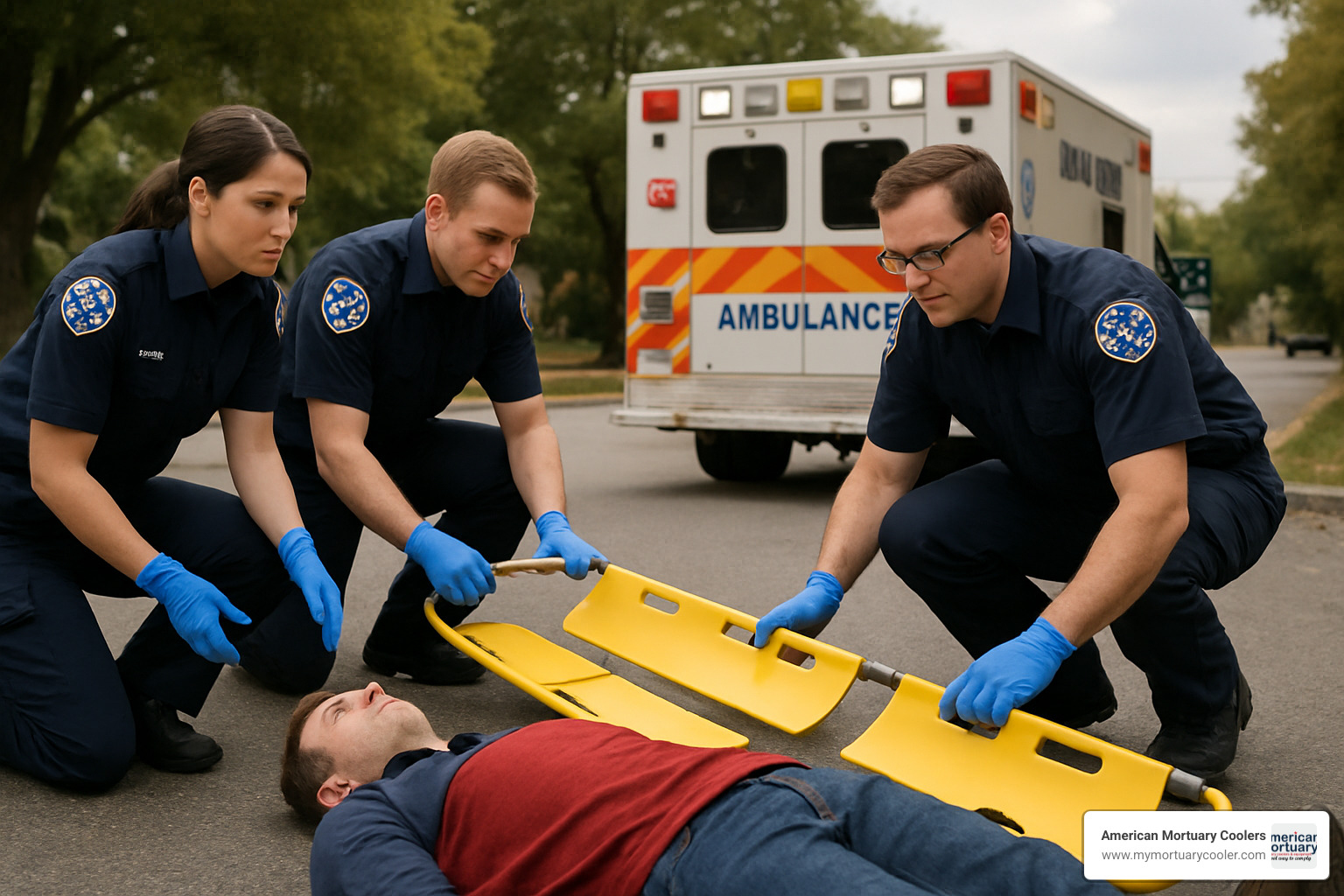
The Definitive Guide to Comparing EMS Stretchers
Why EMS Stretchers Are Critical for Emergency Response Success
An ems-stretcher is a specialized medical transport device designed to safely move patients during emergency situations, featuring adjustable height mechanisms, secure restraint systems, and either manual or powered loading capabilities. Here are the main types:
Manual EMS Stretchers:
- Lightweight aluminum construction
- Require 2-person lifting team
- Cost-effective for basic transport needs
Powered EMS Stretchers:
- Hydraulic or battery-powered lift systems
- 700+ lb weight capacity
- Reduce crew injury risk by up to 40%
Scoop Stretchers:
- Split-design minimizes patient movement
- 30% reduction in secondary injuries
- Ideal for spinal injury cases
Basket Stretchers:
- Rigid frame for rough terrain rescue
- All-weather construction
- Used in wilderness and water emergencies
The evolution from basic canvas cots to today's sophisticated gurneys reflects decades of innovation focused on patient safety and responder ergonomics. Modern stretchers integrate features like automatic loading systems, shock absorption, and integrated monitoring capabilities.
As emergency response teams face increasing call volumes and aging populations requiring bariatric support, selecting the right stretcher can mean the difference between successful patient outcomes and preventable complications.
I'm Mortuary Cooler, a national-level supplier specializing in medical transport equipment including advanced ems-stretcher systems for funeral homes and emergency services.

Ems-stretcher terminology:
Understanding the EMS-Stretcher Landscape
The world of emergency medical stretchers has evolved significantly from simple wooden boards to sophisticated systems designed for patient safety and crew protection. Today's ems-stretcher systems address diverse challenges from cardiac patients in cramped apartments to hiking accidents on rough terrain.
The ambulance cot serves as the workhorse of urban EMS services, while powered gurneys revolutionize heavy patient handling. Scoop stretchers prove invaluable for trauma cases, and basket stretchers remain the gold standard for wilderness rescue.
| Stretcher Type | Weight Capacity | Crew Required | Best Use Case | Average Cost |
|---|---|---|---|---|
| Manual | 350-500 lbs | 2 people | Basic transport | $1,000-2,500 |
| Powered | 700+ lbs | 1-2 people | Heavy patients | $15,000-30,000 |
| Scoop | 350-500 lbs | 2 people | Spinal injuries | $400-800 |
What Is an EMS-Stretcher?
An ems-stretcher serves three critical roles: patient transfer, mobile treatment platform, and safety system. Moving patients safely from accident scenes to hospitals requires navigating stairs, tight doorways, and uneven surfaces while maintaining stability.
Modern stretchers double as mobile treatment platforms where EMTs perform CPR, start IVs, and handle critical procedures during transport. Secure restraint systems protect patients during sharp turns while ergonomic designs protect responders from career-ending injuries.
Timeline of Innovation: From Canvas Cot to Hydraulic Power
Stretcher evolution began in 1902 when firefighter James E. Reeves improved basic canvas-and-wood designs. The 1960s brought aluminum alloy frames that reduced weight while increasing strength. The 1980s introduced hydraulic lift systems, addressing the growing crisis of EMS worker injuries.
Today's automatic loading systems handle 700+ pound patients with minimal human effort, featuring shock absorption, adjustable positioning, and embedded monitoring capabilities.
Core Types & Use Cases
Manual stretchers remain reliable workhorses requiring two-person teams but delivering dependable performance at lower costs. Powered stretchers revolutionize patient handling with battery-operated hydraulic systems managing 700+ pounds with minimal crew effort.
Scoop stretchers excel in trauma cases with split-frame designs that minimize patient movement, showing 30% reduction in secondary injuries. Basket stretchers handle rough terrain and water rescue with rigid frames and all-weather construction.
Bariatric stretchers address growing challenges with reinforced frames handling 700+ pounds safely, while pediatric stretchers provide age-appropriate transport with specialized restraints and child-friendly designs.
Key Features, Materials & Performance Metrics
When choosing an ems-stretcher, focus on weight capacity, crew protection, and durability. Today's stretchers handle patients from 350 pounds to 700+ pounds, addressing real communities where patient weights have increased while EMS crews face more injuries.
Ergonomic features like adjustable height mechanisms and ergonomic handles prevent back injuries that used to end EMS careers. X-Frame design lowers center of gravity for safer transfers, while shock absorption systems smooth patient transport and prevent secondary injuries.

Aluminum alloy frames deliver incredible strength while keeping weight manageable. Carbon fiber composites offer superior weight savings while resisting corrosion. Hydraulic lift systems and automatic loading mechanisms solve real problems identified by EMS professionals dealing with equipment failures and crew injuries.
For comprehensive guidance, Scientific research on stretcher ergonomics provides detailed safety and efficiency recommendations.
Heavy-Duty vs Lightweight: Which Fits Your Fleet?
Heavy-duty systems excel in busy urban environments where 700+ pound load ratings are essential. These powered systems reduce crew injuries and speed response times, making higher investments pay off through lower worker compensation claims.
Lightweight options excel when portability matters more than power. Rural rescue operations prefer stretchers they can carry through tight spaces, with lower costs and simpler maintenance suiting smaller budgets.
Safety Essentials Every Provider Must Check
Restraint systems must secure patients without hindering medical procedures. Quick-release mechanisms must work with gloves during emergencies. Locking wheels prevent accidents in all weather conditions.
Side rails provide patient security while allowing medical access. Cot mounts represent the most critical safety feature, meeting strict government standards to prevent stretchers from becoming projectiles during accidents. Anti-slip surfaces prevent patient sliding during transport, even when wet.
Safety, Ergonomics & Specialty EMS-Stretcher Solutions
EMS responders face injury rates three times higher than construction workers, driving revolution in ems-stretcher design. NIOSH data shows most EMS lateral transfers create over 2,500 pounds of spinal load - equivalent to lifting a small car.
Modern ems-stretcher systems tackle this with automatic loading systems eliminating dangerous manual lifting, ergonomic handles reducing back-twisting positions, and powered systems allowing single-responder operation. Services report injury reductions of 40% or more while improving response times.

Specialty solutions address specific populations: bariatric stretchers handle heavy patients, pediatric configurations ensure appropriate child care, and rescue scoop stretchers excel in trauma situations.
For detailed analysis, Scientific research on Rescue Scoop Stretchers provides comprehensive comparisons and usage recommendations.
Why Rescue Scoop Stretchers Outperform Traditional Boards
Rescue scoop stretchers use split-frame design that separates into halves sliding underneath patients from opposite sides. This eliminates dangerous log-rolling and lifting that can worsen spinal injuries.
Data shows 30% fewer secondary injuries and 20% faster patient handling times compared to traditional stretchers. The ability to secure patients without additional movement has transformed spinal injury response protocols.
Automatic vs Manual Loading Systems
Automatic loading systems use battery-powered hydraulics managing 700+ pound patients with minimal effort. Benefits include 40% reduced crew injuries, faster loading times, and improved short-staffed capabilities.
Manual loading systems maintain value through reliability, simplicity, and cost-effectiveness. Well-staffed services with moderate patient weights often find manual systems perfectly adequate.
Bariatric & Pediatric Considerations
Bariatric stretchers feature reinforced frames, wider surfaces (30+ inches), and powered lifting for patients up to 1,100 pounds in lowest position. Wider frames, improved restraints, and confidence-inspiring designs reduce patient anxiety.
Pediatric considerations focus on comfort and security with pediatric inserts, adjustable restraints, and child-friendly colors. Many agencies prefer modular systems configuring for different patient types rather than separate equipment.
Cost, Maintenance & Smart Procurement
Ems-stretcher procurement involves complex costs beyond initial purchase. Budget planning should account for equipment costs ($1,000-$30,000+), training expenses, maintenance costs, and operational impacts on crew efficiency and injury rates.
Refurbished equipment offers 30-50% savings while maintaining safety standards. Trade-in programs offset upgrade costs, and rental options provide evaluation flexibility.
For detailed guidance, More info about stretcher comparisons provides comprehensive analysis of options and cost implications.
Refurbished or Recertified: Hidden Value
Refurbished ems-stretcher systems reduce costs by 30-50% while maintaining safety standards. The process includes comprehensive inspection, component replacement with manufacturer-approved parts, performance testing, and warranty coverage.
Sustainability benefits extend equipment lifecycle while reducing environmental impact, aligning with growing healthcare sustainability emphasis.
Training & Preventive Maintenance
Training requirements cover safe operation, patient handling techniques, emergency procedures, maintenance protocols, and ergonomic best practices.
Daily maintenance includes visual inspection, testing locks and wheels, cleaning, and battery checks. Monthly professional inspections catch wear patterns before failures. Annual overhauls ensure like-new performance through comprehensive system inspection and component replacement.
Accessory Ecosystem That Boosts ROI
Essential accessories include IV poles, cot mounts for cardiac monitors, stair chairs for multi-story access, and integrated chargers. Advanced accessories offer oxygen holders, storage compartments, warming systems, and communication equipment.
Proprietary cot-mounted systems meet government safety standards, addressing NHTSA concerns about unsecured medical equipment during accidents.
For comprehensive guidance, More info about finding medical stretchers offers detailed equipment matching recommendations.

Frequently Asked Questions about EMS Stretchers
When choosing the right ems-stretcher, three topics generate the most discussion. Getting these decisions right can save lives and prevent career-ending injuries.
Which ems-stretcher type is safest for spinal injuries?
Scoop stretchers are the clear winner for suspected spinal injuries. Their split-frame design slides underneath patients and reconnects around them, eliminating dangerous lifting and rolling.
Research shows 30% reduction in secondary injuries with Rescue Scoop Stretchers compared to traditional stretchers. The patient stays exactly where they are while the stretcher forms around them, like wrapping a protective shell around the injury.
Spinal boards still have their place for absolute rigid immobilization or tight spaces, but scoop designs offer superior patient protection for most scenarios.
How do automatic loading systems reduce crew injuries?
Manual stretcher loading creates over 2,500 pounds of spinal compression force - like having a small car on your spine. Automatic loading systems eliminate heavy lifting with battery-powered hydraulics, allow stretchers to rise to optimal working height, and enable single-responder operation.
Services report up to 40% reduction in crew injuries, translating to fewer worker's compensation claims, less sick time, and healthier careers.
What maintenance schedule maximizes stretcher lifespan?
Daily maintenance includes visual frame inspection, testing locks and wheels, cleaning after use, and checking battery levels for powered units.
Weekly deep checks examine moving parts, lubricate components, and test electrical systems. Monthly professional inspections catch wear patterns before failures. Annual overhauls provide comprehensive system inspection and component replacement.
Well-maintained ems-stretcher systems perform reliably when lives depend on your equipment.
Conclusion
The ems-stretcher industry combines cutting-edge technology with practical experience. Future innovations include AI-equipped stretchers that automatically adjust to patient needs and smart sensors monitoring vitals while providing real-time equipment status.
These capabilities build on proven technologies: automatic loading systems saving crews' backs, scoop designs protecting spinal patients, and bariatric platforms handling changing demographics. The results speak volumes - crew injuries drop 40%, secondary patient injuries decrease 30%, and response times improve 20%.
At American Mortuary Coolers, we help facilities across Tennessee, Atlanta, Chicago, Columbia, Dallas, Los Angeles, New York, Pittsburgh, and every region find the right stretcher solutions. There's no one-size-fits-all answer - rural Montana services have different needs than busy urban Chicago departments.
We understand each agency's unique situation, whether dealing with budget constraints requiring manual systems, aging workforces needing powered systems, or specialized requirements demanding custom solutions.
For agencies starting their research, Medical Stretchers 101 offers comprehensive technology and options guidance.
The investment in quality ems-stretcher systems means investing in team safety and community wellbeing. Reducing crew injuries keeps experienced responders working longer. Improving patient outcomes strengthens service trust. Boosting operational efficiency serves more people effectively.
Whether replacing aging equipment or building new services, the right stretcher system will serve your community for years. Take time to evaluate options, understand technology, and choose equipment that grows with your needs.
The future of emergency medical transport continues brightening, and we're proud helping agencies nationwide build foundations for that future, one stretcher at a time.



